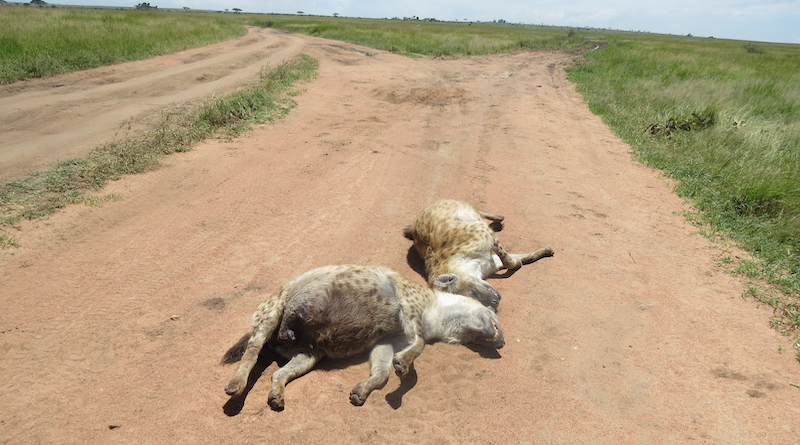Hyenas Die Also In Road Accidents
What factors influence the risk of fatal collisions between vehicles and spotted hyenas in the Serengeti? Findings from a long-term study over three decades
The Serengeti in Tanzania is home to large populations of wildlife species, including spotted hyenas (Crocuta ocaliz). While many human activities are prohibited in the national park, driving is allowed in and through the protected area. Using a 34-year long-term data set, a scientific team from the Leibniz Institute for Zoo and Wildlife Research (Leibniz-IZW) analysed which factors contribute significantly to hyenas being run over and killed by vehicles. The results of the analyses indicate that mainly two factors play a role: firstly, the characteristics of the road and secondly, the annual migration of the large ungulate herds in the Serengeti and the associated seasonal changes in the ocalization of the prey animals of the spotted hyenas. These findings provide new insights into which ecological and individual factors influence predators’ risk of fatal collisions with vehicles and were published in the scientific journal Biological Conservation.
Even in protected areas, many wild animals are killed by vehicles worldwide, and these negative impacts of roads continue to increase due to the rise of human populations on the borders of protected areas and the growing interest in wildlife tourism. However, the factors that contribute to fatal collisions between vehicles and wildlife are still poorly understood.
As part of a long-term study in the Serengeti National Park, the Leibniz-IZW scientists found a total of 104 spotted hyenas that had been run over between 1989 and 2023. Based on these cases, they investigated the question of which spatial and temporal factors particularly contribute to spotted hyenas being run over and killed by vehicles, and whether spotted hyenas of one age group, sex or social status are particularly affected. Long-term studies of this kind are rare. The Serengeti is criss-crossed by a network of roads. The main roads are gravel roads used not only by tourist vehicles, scientists and park staff, but also by trucks, supply vehicles and national bus lines throughout the year. In addition, there are a large number of unpaved wildlife observation and camp access “tracks”.
Overall, two factors proved to be crucial. Firstly, hyenas were more often run over on main roads than on “tracks”, probably because there is more traffic on main roads and vehicles travel faster there. Secondly, the timing and location of fatal collisions varied with the seasonal migration of the large herds of ungulates (wildebeest, zebra and Thomson’s gazelles), which are the main prey of Serengeti spotted hyenas. The results are consistent with other studies showing that the risk of being killed by a vehicle increases with the mobility and distance travelled by the animals.
In addition, killed hyenas were found particularly close to watercourses, human dwellings, to which the hyenas are presumably attracted by the presence of human food waste.
“Contrary to expectations, the seasonal variation in the number of tourists in the region did not seem to play a role in the level of mortality,” says Marwan Naciri, who joined the Leibniz-IZW for this project and is the lead author of the publication.
A special feature of the dataset used in this study is that some of the hyenas that were run over were individually known and therefore factors of their life history could be included in the analysis. For example, the analyses show that adult females were most frequently run over, probably because they are the ones who regularly have to travel long distances between their den and migrating prey herds in order to be able to hunt on the one hand and nurse their cubs left at the den on the other.
“Injuries from illegally laid wire snares also particularly affect adult female hyenas, as we found in a previous study,” says Leibniz-IZW scientist Sarah Benhaiem, involved in both research projects. In summary, roadkills and death by snares could be one of the main causes of death for adult hyenas in the Serengeti. It is still unclear whether this mortality, which mainly affects adult females, threatens the continued existence of the spotted hyena population in the Serengeti.
Road networks in the Serengenti are likely to expand in the coming decades, including in protected areas. Knowledge of the factors that contribute to fatal collisions between vehicles and wildlife, such as road characteristics, will help design effective mitigation measures, such as reducing the speed and number of vehicles on main roads. Good planning of road construction and implementation of mitigation measures will be essential to ensure wildlife conservation in protected areas.

